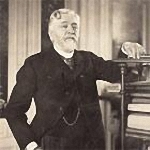
As a youth he apprenticed to become an engraver and took evening courses to deepen his knowledge in the field.
He became a qualified engraver in 1876 and left for London with Froment, his employer, the following year.
Back in France in 1879, he was enlisted in the army but managed at the same time to study painting with Carolus Duran while Pissarro advised him much.
Camille Pissarro, who shared his anarchist convictions, introduced him to Georges Seurat (1859-1891) and Paul Signac (1863-1935). Luce became one of the founders of the Neo-Impressionist School (i.e. the Pointillists). For many years Luce adhered to the Divisionist technique of color separation and theories of the scientists Michel Chevreul, Charles Henry and Ogden Rood. But, far from having the detached approach of Georges Seurat, Luce portrayed the contemporary world with passion.
Luce adhered in 1887 to the Society of the "Independents" and took part regularly in the exhibitions of that group regarded as an avant-garde movement during the first decade of its existence.
Luce was always very interested in the worries and pains of ordinary people and attempted to honestly transmit such human plight in his portrayal of lockers, masons and other laborers whose daily work he witnessed. In fact, in his youth, Luce had been quite struck by the notion of 'the commune' and he subscribed to Anarchist magazines such as La Revolte and L'assiette au beurre and was implicated in 1894 for politically incorrect behavior, for which he was imprisoned for a while and then sought refuge in Charleroi, Belgium, where he promoted Neo-Impressionism. Luce maintained strong ties with the Belgian Pointillist Théo van Rysselberghe (1862-1926).
He painted many landscapes as well as city scenes and, as a demonstration of his deep concern for the working-class, he depicted workers in various attitudes.
After 1920, however, when he began spending a large amount of time around Rolleboise, Luce started to paint in a freer manner.
Luce succeeded Signac as President of the Society of Independent Artists in 1935 but resigned his post in 1940 in protest against racial laws enacted by the Vichy regime, which barred Jewish artists from all official groupings and exhibitions.
Maximilien Luce remains a very important figure in French Post-Impressionist Art, as a Pointillist and a social realist.